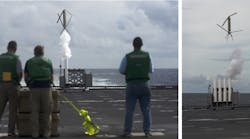Engineers from the U.S. Naval Research Laboratory successfully completed testing of their Nomad drone from a Navy ship, demonstrating its improved launch and control capabilities. The Navy also launched several Nomads in quick succession, conducted formation flying, and recovered all the drones sequentially onboard ship.
Nomad, which stands for Netted Offboard Miniature Active Decoy, is a low-cost rotary-wing vehicle with upper and lower rotors that unfold when it leaves the launch tube. It measures 3 ft long and has a rotor diameter of 6 ft. The Nomad decoy launches from a tube 4 ft in length with a diameter of 6 in, according to the U.S. Office of Naval Research. The drone’s built-in launch tube also serves as compact, light-weight storage and makes the drone well-suited for quick-reaction launches.
Nomad is a rotary wing UAV said to have been designed originally as a decoy that emits electromagnetic radiation, mimicking a ship or aircraft. But it will likely also serve as a testbed for remote controls, autonomous flight controls, station keeping, and coordinated flight support for any type of possible payload.
The Nomad’s low cost makes it expendable and a candidate for carrying out mission without concerns for its return to the ship. But it also has recovery features that lets operators retrieve and reuse the Nomad drones several times. During the demonstration, for instance, it landed vertically onboard the ship, propped up by four legs.
The drone’s launcher originally handled one-at-a-time, non-pyrotechnic launches using CO2 ejection from the launch and storage tube, a safer alternative to pyrotechnic launchers. The system now has multi-launch capability, deploying several Nomads—each from its own launch tube—in quick succession instead of singularly, while retaining the system’s safe CO2 ejection.


